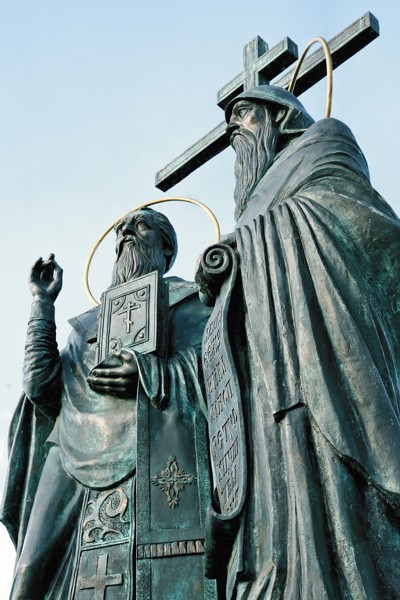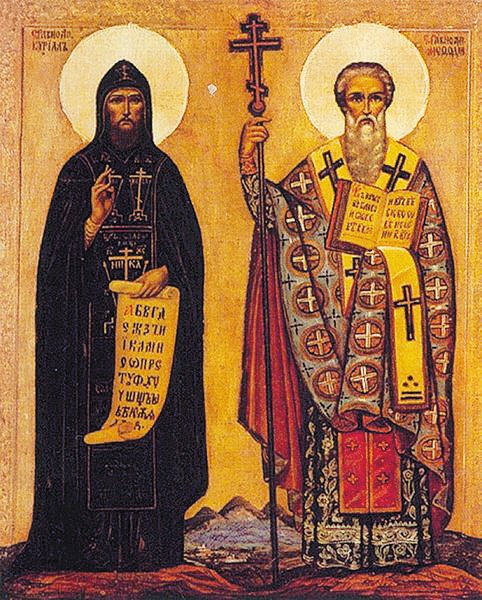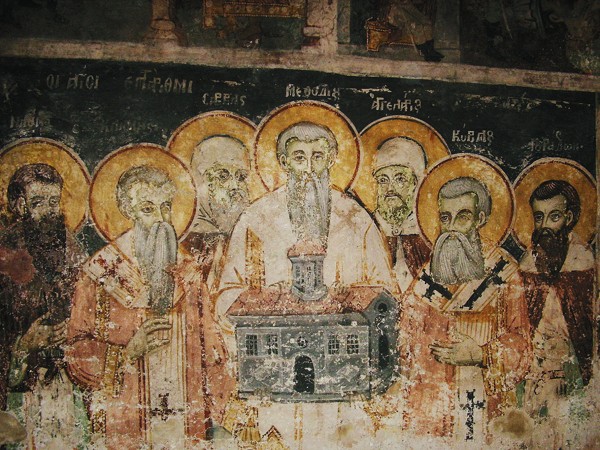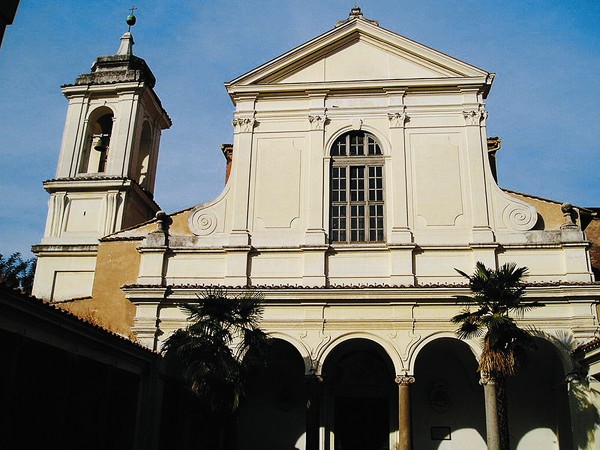![]() — Russkiy Mir Foundation — Journal — Articles — Apostles to the Slavs
— Russkiy Mir Foundation — Journal — Articles — Apostles to the Slavs
 Apostles to the Slavs
Apostles to the Slavs
Day after day the two brothers at the Polychron Monastery filled the parchments with some mysterious characters that amazed other monks, then scraped them off and covered the thick sheets with very unusual letters again...

It can be surmised that this was roughly the method used by the brothers Methodius and Cyril to create the first Slavonic alphabet. Even today scholars disagree about the location of Polychron, though most tend to believe that it was nested in the rocky shores of ancient Hellespontes, which we call Dardanelles nowadays. It is here that the first book in Slavonic most likely appeared, namely the brief Aprakos beginning with the first sentence from the Gospel of John: "In the beginning there was the Word, and God had the Word, and the Word was God."
Russian Chronographer as of 1512 gives a meager report: "Constantine the Philosopher and his brother Methodius translated the sacred books from Greek to Slavonic, since Bulgarians, Slovenians, Serbs, Bosnians and Russians all spoke one language." Extant until now are more ancient Slavonic sources, containing a much more scenic portrayal of the life of the great brothers, even though they smack of a legend. But then Latin documents come to our aid: the letters of Anastasius the Librarian and Roman pontifics, Arab chronicles and even a letter from Khazar khagan Joseph to rabbi Hisdai. They corroborate some facts mentioned in the hagiography of the Saints Methodius and Cyril.
But there is a mystery that concerns historians: Methodius and Cyril played a prominent role in the diplomacy of the Eastern Roman Empire; furthermore the Philosopher was close to Emperor Mikhail III, but Byzantine sources keep silent about the brothers. They are not even mentioned by Constantinople Patriarch Photius – Cyril’s teacher and friend who left rich literary heritage...
Second eye of the empire
Thessalonica was famous across the empire for its glass craftsmen and armorers. Here the best vessels in Byzantium were built, beautiful silk and linen fabrics were woven, and Thessalonians were very good at curing leather...
Since 315 B.C., when Macedonian king Cassander founded Thessalonica, having named it in honor of his wife – step sister of Alexander the Great – the city had seen a lot. Its old trade streets were overcrowded: here you could hear spoken Greek, Syrian, Hebrew, Persian, Slavonic and Armenian... Yet the Slavonic tribes that migrated from the North to the Balkan Peninsula would describe Thessalonica as "Solun". Byzantine writers christened the city as "the second eye of the empire", "overseeing the western provinces". Unsleeping vigilance was needed: a Byzantine garrison quartered in Solun had to endure frequent sieges by Slavs. Serving at that garrison was a Byzantine officer named Leo. His wife Mary is considered by some historians as a Slav by origin, while others insist she was a representative of a noble Byzantine family. Leo too most likely belonged to the higher nobility. Thus during his Khazar mission, answering the question of the khagan about his origin, Cyril said: "I had a great and famed grandfather who was close to the emperor, but denied that glory and was banished. He became impoverished in a foreign land and begot me. Seeking the honors of my grandfather, I have not found it since I am a grandson of Adam"...
We do not know how many children Leo and Maria had, since only the older and the youngest sons went down in history: Methodius born in 815 A.D. and Cyril in 827 A.D. When Methodius turned 18 he chose a military career. He was taken note of in Constantinople where he served, and already in 835 Methodius was appointed a commander to one of the Slavic provinces. He served a ten-year tenure and probably learned the language of local dwellers, according to his Hagiography. A particular province where Methodius served is unknown. Then Methodius suddenly took a monastic vow and left for a monastery...
Since his early years Cyril staggered those around him with his talents and brilliant memory. From his childhood he had a propensity for theology and philosophy, wrote poems and loved reading the works of St. Gregory the Theologian. He was the best student at school. In 840 a new archbishop arrived in Thessalonica: famous Leo Mathematician, one of the greatest brains of his epoch, a brilliantly educated scholar. Most likely he put in a word for the child prodigy from Solun to the top-ranked official of the royal chancellary Theoctistus, and Cyril was invited to Constantinople where he continued his education. This probably happened not sooner than 843 A.D., when the Mathematician, having abandoned the Bishop's Office in Solun returned to the capital city.
Living in the capital
In 842 A.D. Byzantine Emperor Theophilus, a convinced iconoclast, passed away. While most dwellers of the capital city venerated icons, Theophilus was greatly respected by his subjects for his integrity and straightforwardness. On one occasion he ordered the freight of the trade vessel owned by his wife Theodora be burned in a city square, stating that it did not befall an imperial family to engage in trade. On another occasion he had Theodore's brother publicly scourged because the latter oppressed his neighbors, being confident in his impunity. Theophilus' heir was his son – infant emperor Mikhail II, with Theodora being his co-regent. The actual ruler of the empire was Theoctistus, though. It is stated in Cyril's hagiography that he became a senior associate of the emperor boy, assisting in his education. And Cyril continued his education in Pandidacterion – a university founded in 849 at Magnaura Palace by Theoctistus and Varda, an uncle of the youthful emperor. In Magnaura, where only young aristocrats were studying, they taught mathematics, astronomy, grammar, rhetoric, geometry, music, antique and Christian philosophy, theology and history. Best teachers of the time had chairs here – future Constantinople patriarch Photius, Leo Mathematician, Theodore, Comitas, Theodegius...

In mid-9th century the empire had to repulse a heavy pressure from Slavs and Arabs, while in Constantinople the controversy between iconclasts and icon venerators, spinning intrigues around the imperial throne, was going on. At the same time Byzantium was experiencing another heyday of culture, with educated people being in demand by those in power. Constantine was noticed and he was the hope of powers that be. Theoctistus invites the youth to live in his house and tries to persuade him to marry his goddaughter – a girl from a rich and noble family. Constantine refuses and becomes a priest. He is appointed a hartophilax (librarian) at St. Sofia Church and carries out the obligations of the first secretary of Constantinople patriarch Ignatius. But soon he secretly escapes from the capital. It is not known what happened, but later in one of his letters to future antipope Anastasius the Librarian who personally knew Constantine wrote that Ignatius held a very negative attitude towards secular literature, despising those who engaged in it. Constantine probably had to flee because of his differences with the patriarch.
He was looked for half a year and finally discovered in one of the small monasteries. Constantine refused to get back to the work of hartophilax, but agreed to helm the chair of philosophy in Magnaura. The glory of the brilliant young teacher spread rather quickly and from that moment they began calling him Cyril the Enlightener.
In 856 Varda, the uncle of Emperor Mikhail III, organized the assassination of Cyril’s patron Theoctistus and placed his sister, Empress Theodora, in a cloister, having usurped the actual power in the empire. But fate is a capricious lady and ten years later Varda would perish as a result of conspiracy plotted by the favorite of Mikhail III – future Emperor Basil of Macedonia...
The lot of missionaries
Shortly before his death Theoctistus sent Cyril for his first missionary trip to Arabs, "the saracenes" as they were referred to in Byzantium. Scholars point out that the mission could happen only during short periods of truce between the Empire and Arabs: 845, 855-856 and 859-860 A.D. In 845 Cyril was too young, in 859-860 the Arab mission was spearheaded by shrewd old diplomat named Atrubilis. This means that Cyril went on his tour in 855-856. It is known that Cyril was accompanied in his journey by asicritos (secretary of the royal chancellary) George. According to the Saint's hagiography, Cyril led the mission while George was his aide. Yet the Arab chronicle of Abu Jafar Tabari indicates that George was the actual head of the mission whose main purpose was exchanging prisoners-of-war. Constantine was to enter into a theological dispute with Arabic scholars. The trip ended in a success: on the banks of the Cilician river Lam an exchange of prisoners-of-war took place, while the Cyril prevailed over the Arabian theologians in a dispute, having demonstrated his knowledge of the Quran.
But upon Cyril’s return to Constantinople disfavor rather than triumph awaited him. His patron Theoctistus was assassinated and his associates were escaping from Varda's persecution. Cyril also leaves the capital city and finds a shelter at his brother's monastery. Nobody knows what Cyril did there: briefly mentioned in his hagiography is the fact that " Cyril was conversing with books". This "conversation" did not last long: already in 860 A.D. Emperor Mikhail III summons Cyril to Constantinople and sends him for a mission to the Khazars.
The Khazar Khaganate was one of the main political players in the Lower Volga region and in Northern Black Sea region. In the previous century the Khazars, with the capital in Itil (now the Astrakhan region) regained part of the Crimea from Byzantium and went on threatening the Empire, so that Constantinople preferred to maintain friendly relations with the Khaganate. Khazars were Judaists, but in the IX century Christianity and Islam started gradually penetrating the Khaganate. Theological disputes were one of the favorite entertainments of various despots and so no wonder that the Khaganate sent its envoys to Constantinople, suggesting that Michael should send a well-versed scholar to Itil. The Khaganate's letter stated in accordance with the hagiography: "If he overpowers Jews and Saracenes in a dispute we'll be converted to your faith."

The mission led by Cyril the Enlightener included also his brother: "Cyril persuaded his brother Methodius to go with him because Methodius could speak Slavonic," informs the Hagiography of Methodius. Preparations for the mission were made in Tauric Chersonese which the Byzantine ambassadors reached in the fall of 860 and stayed there until the end of winter 861. It is here that Cyril organizes a successful search of the relics of Saint Clement, the Pope of Rome who lived at the turn of the second century A.D. For his ardent outreach campaign Clement was banished by the Roman Emperor Trajan to Chersonese where the early Christians and criminals were often exiled. The Roman high priest was sentenced to hard work at the local quarries where he went on preaching. In the end the governor of Chersonese had him tortured and baptized with blood: Clement was tied to an anchor and thrown into the sea. As the tradition goes, the sea miraculously receded, having exposed the saint's body 300 meters off the shore. According to the hagiography, Cyril with a local bishop and clergy found the relics of Saint Clement on a tiny isle out in the sea not far from the coast. The relics were solemnly carried to a local cathedral and part of it was retained by Cyril. It should be noted that in the next century, when great prince Vladimir vanquished Korsun (the Russian name for Chersonese) and was baptized there, he took away the head of Saint Clement to Kiev. The relic was most likely placed in the Tithe Church in the capital of ancient Rus' and probably perished in a horrible fire, when Kiev was desolated by khan Batu. As a matter of fact, it is after Rus was baptised by Prince Vladimir in 988 that literacy and books started their march over the country...
While Cyril sojourned in Chersonese, he learned Hebrew because he thought it inadmissible to hold a dispute with Jews without knowing the language of Tora and the Old Testament. Cyril found a teacher in the midst of a rather large Jewish community in Chersonese. In addition, there is one enigmatic report about the Chersonese period: "And he found here the Gospel and Psalms written in Russian letters and he found a man speaking this language. And he talked with him, coming to grips with the power of this speech by comparing it with his mother tongue. He also learned to discriminate between vowels and consonants and, praying to his God, he soon began reading and speaking." Scholars still rack their brains over this paragraph. The boldest ones assert that this provides the evidence that old Slavonic writing had existed before Cyril and Methodius, although no convincing proofs have so far been found. Others believe that this excerpt is a later interpolation; still others are positive that this is the copier's mistake: the correct reading would be "Surian", i.e. "Syrian writing", rather than "Russian"....
In spring of 861 A.D. the mission made their way to the Khazars. Cyril the Enlightener entered into disputes with Jews, pagans and saracenes and each time came out a victor. Be that as it may, Khazars were not converted to Christianity, but the khagan wished to thank Cyril with wealthy gifts. Yet the Cyril declined the gifts and asked to release Byzantine captives. In the fall of 861 the mission returned to Constantinople with 200 liberated Byzantine compatriots. The Emperor received Cyril, but then for unknown reasons the Enlightener was removed from the court, deprived of his chair at the university and became a humble teacher at the Church of Twelve Apostles. Methodius was appointed a prior of Polychron Monastery and soon Cyril moved to his brother's abode...
Slavonic reading and writing
The 9th century marked a heyday of the first in history large Slavonic state: the Greater Moravia that included today's territory of Hungary, Slovakia, Czech Republic as well as Minor Poland, part of Ukraine and Silesia. Greater Moravia that lasted less than a century had already been converted to Christianity, staying under the protectorate of the Roman Church (until the Great schism of 1054 that finally split the Church into Catholic and Orthodox, the Christian community of the West and the East was regarded as a single whole). Liturgies were served in Latin here, bishops were appointed by Roman popes, and Bavarian clergy dominated the priestly milieu.
Moravian prince Rostislav, counteracting the attempts of Ludwig II German, king of Francia Orientalis, to enthrall Moravia, expelled Bavarian priests and sent his envoys to Rome requesting for teachers to train local church ministers and to introduce the Slavonic liturgy. The Roman Curia did not like this idea. Then Rostislav sent his envoys to Constantinople in 863. The Empire responded instantly: first of all, Byzantine Church did not mind the liturgy to be organized in local languages and, secondly, an alliance with Moravia would strengthen Constantinople's positions in Central Europe and help Byzantium repel a new onslaught of Bulgarians and Russians.

Michael III called upon Cyril the Enlightener to describe the gist of the problem. Experts in Slavic studies agree that it is in 863 that the first Slavonic alphabet was created – in Constantinople or at Polychron Monastery. The majority is inclined towards the latter version: it is known from the hagiography that both brothers were working on the alphabet (the new alphabet was pivoted on Greek cursive or minuscule writing). The Pannonian hagiographies of Cyril and Methodius unanimously report that the alphabet did not take long to create. In addition, it was necessary to come up with a new terminology, translating Greek liturgical words into Slavonic. It was also necessary to translate the Aprakos that was essential for worship. Therefore many scholars assume that the brothers were assisted by Polychron monks having a Slavic origin...
Already at the end of 863 the brothers helming the mission make their way to Greater Moravia, bringing with them the Slavonic alphabet, most likely Aprakos, a letter from Michael III to Rostislav, and rich gifts. Rostislav received Byzantine missionaries with honors and offered them a free hand in all their undertakings. The hagiographies assert that Cyril and Methodius stayed 40 months in Moravia, that is, until the spring of 867 A.D. The results of the mission were so impressive that Pope of Rome Adrian II wrote to Rostislav with regret: "The Emperor had sent to you blessed Cyril the Enlightener with his brother before we had time to send one of our missionaries." Yet the brothers' mission was not easy: they had to set up the worship in the local language, explain innovations to the local population, continue translating the liturgical books, educate successors and withstand the intrigues of Bavarian clergy. They also had to keep in mind Rome's stance, given that Moravia was under the Pope's ecclesiastical authority.
This was a real challenge: although as early as at the Frankfurt Council of the VIII century and subsequent councils the Roman church allowed preaching in local tongues, it actually discouraged this practice. Things were further aggravated by the fact that after Rostislav was defeated by the united front of Germans and Bulgarians in 864, Bavarian clergy advocating three liturgical languages stirred to greater activity again. Its proponents adhered to the teaching of Isidorus of Sevilla he disclosed in his Etimologies dating from the VII century: "... there are three sacred languages: Hebrew, Greek and Latin for they are extolled above any other languages across the world. This stands to reason because in these languages Christ's guilt was written on a plaque attached to his cross." Orthodox theoloigians considered this doctrine heretic and dubbed its champions as "tripagans-Pilateans". The Roman Church recognized three languages as sacred, but in practice used only Latin. Thus Pope John VIII wrote in 880 A.D. to Svyatopolk I, successor to Rostislav as the Prince of the Greater Moravia, that he did not ban Slavonic liturgies, but added: "We nevertheless rule that in churches of your land the Gospel should first be read in Latin for greater veneration and only then in Slavonic for those commoners who do not understand Latin."
Cyril and Methodius trained many disciples from among the local Slavs. The hagiographies particularly praise Gorazd, Naum, Angelarius, Savva and Clement (future Saint Clement of Ohrid, the founder of the famous Ohrid shcool, educator and Bulgarian archbishop). The brothers faced a serious problem, though: since neither of them was ordained to bishopric, they could not impose hands on their disciples. In 867 the brothers set out for Venice and whence to Constantinople. They were accompanied by a large group of his disciples who were to be ordained to priests in the capital of Byzantium.
The brothers stayed in Venice for quite a long time. The reason is unknown, but many scholars surmise that it could have something to do with the deterioration of relationship between Rome and Constantinople. At that time Nicholas I was the Pope and Photius, the mentor of Constantine the Philosopher – the Patriarch of Constantinople. Photius rebuked the popes of leadership mania and he was the first to denounce Rome for adding the phrase "and from the Son" to the Nicean Creed; furthermore the interests of the two sees came into stark collission over the issue of jurisdiction over Bulgaria and Southern Italy. In 863 Nicholas I excommunicated Photius, while Photius anathematized the Pope in 867.
In the same year Emperor Michael III was assassinated by conspirators and Basil of Macedonia ascended the throne. The new emperor removed Patriarch Photius and reinstated Ignatius on the Patriarch's throne, from whom Cyril had to leave for the monastery in his youth. It cannot be excluded that the brothers decided to wait out in Venice and the relics of Saint Clement that Cyril took with him everywhere came in handy. Pope Nicholas I, upon getting a message about the relics of Saint Clement, invited the brothers to Rome where they arrived with their disciples in late 867 or early 868. By that time Nicholas I had died and Adrian II was elected new Pope. The newly elected pontific gave a solemn reception to the brothers, recognized the Slavic liturgy and consecrated the books in Old Church Slavonic. The brothers settled in a Greek monastery in Rome together with their disciples who were finally ordained. Cyril continued participating in disputes, but in late 868 fell seriously ill and shortly before his death he took a monastic vow and the name of Cyril. His hagiography testifies that even on his deathbed Cyril prayed: "Lord, destroy the three-language faith..." Cyril died on February 14, 869 and was buried in Saint Clement Basilica in Rome...
Meanwhile Methodius was elevated to bishopric in Rome, in 870 A.D. and appointed the archbishop of Pannonia that became the second important center of Slavic writing next to Greater Moravia. As in Moravia, Methodius again encountered the opposition from Catholic clergy: in 873 he was incarcerated, beaten, tortured and kept in the open sky on a cold winter day, although at that time Methodius was in his fifties... Only the intercession of new pope John VIII helped deliver Methodius from imprisonment. The same pontific officially recognized the Slavic liturgy and allowed it in Pannonia and Moravia ruled by Svyatopolk I who looked to German clergy and stood for Latin liturgies. It is Moravia that Methodius visited after his release from prison and it is there that he starts translating the Old Testament to Slavonic with his two disciples. This work was finished shortly before his death. On April 6, 885 Methodies dies leaving behind him about 200 Slavic presbyters and deacons. Nobody knows exactly where Methodius was buried: in Velegrad or Devin.
***
If you happen to be in Rome we recommend you to find Saint Clement Basilica squeezed between the Coliseum and Lateran Cathedral. Here you may pay tribute to one of the two apostles to the Slavs: Saint Cyril. Our gratitude to the Thessalonian brothers canonized by the Orthodox and Catholic churches knows no bounds and can hardly be expressed in words...
Author: Lada Klokova




